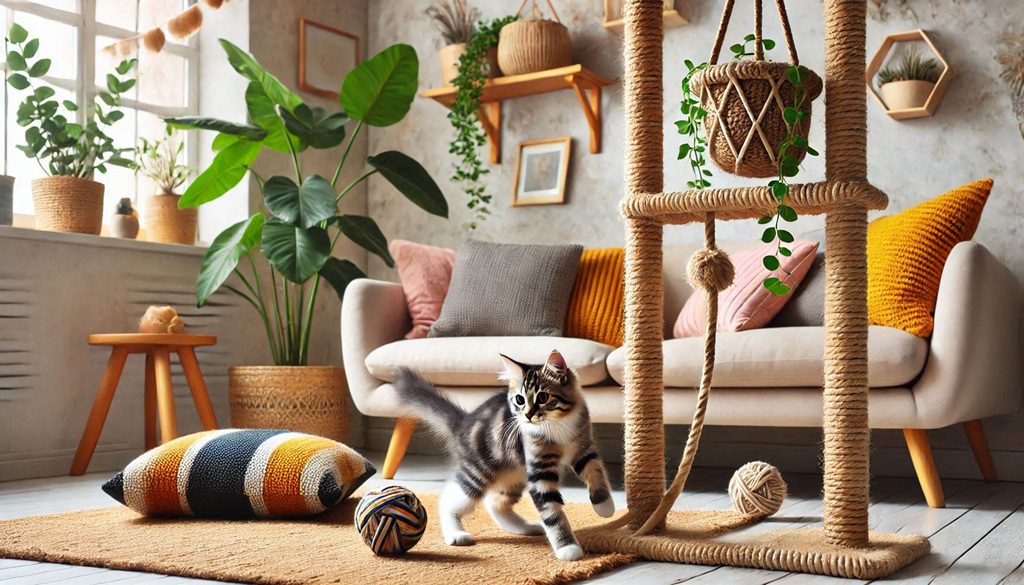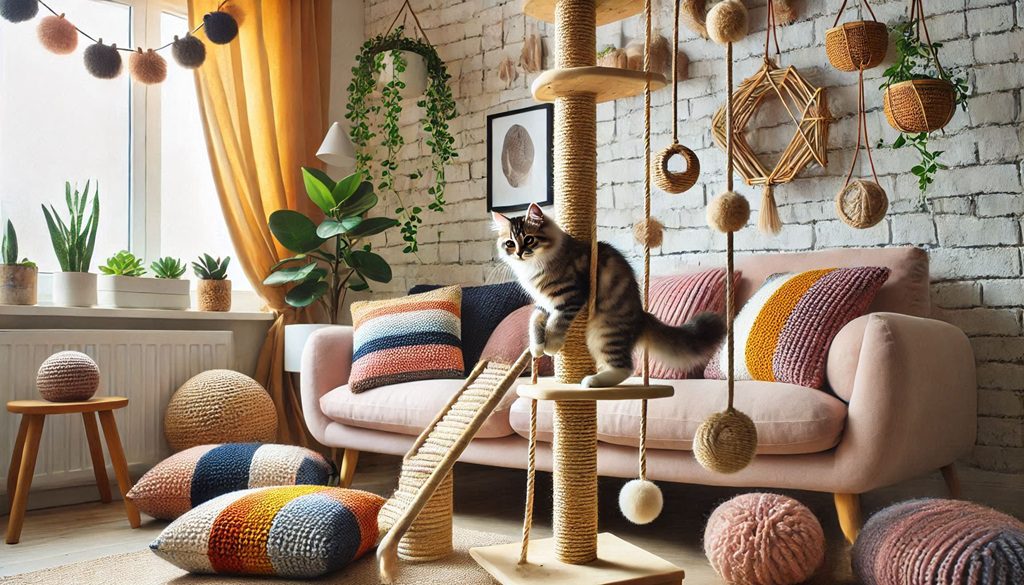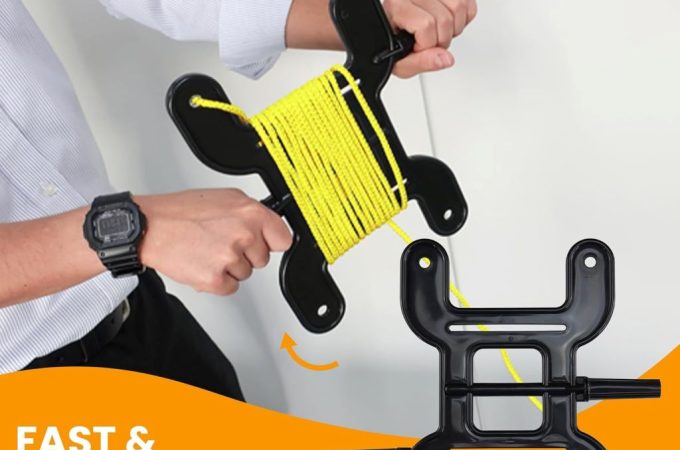
Unleash Your Inner Tiger: The Ultimate Guide to DIY Cat Climbing Rope
Cats are natural climbers. Their ancestors scaled trees to hunt and escape predators, and that instinct remains strong in our domesticated felines. Providing your cat with opportunities to climb satisfies this innate need, offering physical exercise, mental stimulation, and a sense of security. A DIY cat climbing rope is a fantastic way to enrich your cat’s environment while adding a touch of rustic charm to your home. This comprehensive guide will walk you through everything you need to know, from choosing the right materials to creating a captivating climbing haven for your feline friend.
Contents at a Glance
ToggleWhy Your Cat Needs to Climb
Before we dive into the DIY project, let’s explore why climbing is so crucial for your cat’s well-being:
- Physical Health: Climbing engages various muscle groups, promoting strength, flexibility, and balance. It’s an excellent way to keep your cat active and prevent obesity, a common health issue in indoor cats.
- Mental Stimulation: Climbing provides a challenging and engaging activity that prevents boredom and reduces destructive behaviors often associated with pent-up energy. Watching your cat navigate the rope challenges their mind and keeps them entertained.
- Emotional Well-being: Elevated spaces provide cats with a sense of security and control over their environment. They can observe their surroundings from a safe vantage point, reducing stress and anxiety.
- Scratching Outlet: Incorporating sisal rope into your design offers a satisfying scratching surface, diverting your cat from furniture and carpets.
Choosing the perfect Rope
Selecting the right rope is crucial for safety and durability. Here are the key factors to consider:
- Material: Natural fibers like sisal, jute, or hemp are ideal. They’re strong, durable, and provide excellent grip for your cat’s claws. Avoid synthetic ropes like nylon or polyester as they can be slippery and may fray easily.
- Diameter: Aim for a rope with a diameter of at least 1 inch. This ensures a comfortable grip for your cat and prevents the rope from being too thin and potentially dangerous.
- Durability: Choose a tightly woven rope that can withstand your cat’s weight and scratching. Check for any signs of fraying or weakness before purchasing.
Where to Find the Right Rope:
- Local hardware stores: Often carry a variety of natural fiber ropes suitable for this project.
- Online retailers: Amazon, Etsy, and specialized pet supply stores offer a wider selection of ropes and climbing accessories.
- Marine supply stores: These stores typically stock high-quality, durable ropes designed for nautical use, which are also perfect for cat climbing projects.
Gathering Your DIY Arsenal
Once you’ve chosen your rope, it’s time to gather the rest of your supplies:
- Wooden dowel or sturdy branch: This will serve as the base for your climbing rope. Choose a diameter that’s comfortable for your cat to grip.
- Ceiling hook or wall-mounted bracket: Ensure it’s rated to hold your cat’s weight and the weight of the rope.
- Drill and drill bits: These are used to create pilot holes in the dowel or branch.
- Screws or strong adhesive: To secure the rope to the dowel or branch.
- Scissors or a sharp knife: For cutting the rope to your desired length.
- Sandpaper: To smooth any rough edges on the dowel or branch.
- Optional: Carpet remnants, fabric scraps, or feathers for added enrichment.
Crafting Your Cat’s Climbing Paradise
Now, let’s get down to the exciting part – building the climbing rope!
Here’s a step-by-step guide:
- Prepare the dowel/branch: Sand any rough edges and drill pilot holes where you’ll attach the rope.
- Secure the rope: Thread the rope through the pilot holes and secure it firmly using screws or strong adhesive. Ensure the knots are tight and won’t unravel.
- Attach the hanging mechanism: Install the ceiling hook or wall-mounted bracket according to the manufacturer’s instructions.
- Hang the rope: Connect the dowel/branch to the hanging mechanism. Ensure it’s securely fastened and can withstand your cat’s weight.
- Add enrichment (optional): Tie carpet remnants, fabric scraps, or feathers to the rope to provide additional stimulation and encourage play.
Safety First:
- Always supervise your cat when they’re using the climbing rope, especially in the beginning.
- Ensure the rope is securely attached to both the dowel/branch and the hanging mechanism.
- Regularly inspect the rope for any signs of wear and tear. Replace it immediately if you notice any damage.
Creative Climbing Rope Ideas
The basic design is just the starting point. Unleash your creativity and customize the climbing rope to suit your cat’s personality and your home décor:
- Multi-level climbing rope: Create a challenging climbing structure with multiple ropes hanging at different heights.
- Rope bridge: Connect two elevated platforms with a rope bridge for adventurous exploration.
- Spiral staircase: Wrap the rope around a sturdy post to create a spiral staircase effect.
- Themed climbing rope: Decorate the rope with elements that match your cat’s personality or your home’s theme.
DIY Cat Climbing Rope: Reviews
Many cat owners have embraced the DIY climbing rope, and the reviews are overwhelmingly positive:
- “My cat absolutely loves it! He spends hours climbing and playing on it.” – Sarah J.
- “It was easy to make and looks great in my living room. My cat is much more active now.” – Mark L.
- “This is the best thing I’ve ever made for my cat. It’s provided him with endless entertainment.” – Emily S.
These testimonials highlight the benefits of DIY cat climbing ropes, from promoting physical activity and mental stimulation to enhancing the overall well-being of your feline companion.
Related: Unleash the Fun: DIY Rope Dog Toys for Hours of Entertainment (and Chewing!)
Frequently Asked Questions (FAQ)
Q: What type of rope is best for a cat climbing rope?
A: Natural fibers like sisal, jute, or hemp are recommended due to their strength, durability, and excellent grip.
Q: How thick should the rope be?
A: Aim for a rope with a diameter of at least 1 inch to ensure a comfortable and safe grip for your cat.
Q: Where can I buy the materials for my DIY cat climbing rope?
A: Local hardware stores, online retailers like Amazon and Etsy, and marine supply stores are good places to find the necessary materials.
Q: How do I clean my cat’s climbing rope?
A: You can vacuum the rope regularly to remove dust and debris. For deeper cleaning, spot clean with a mild detergent and water solution.
Q: Can I use a real tree branch for my climbing rope?
A: Yes, a sturdy tree branch can be a great natural option. Ensure it’s properly cleaned and sanded to remove any rough edges or potential pests.
Q: My cat isn’t interested in the climbing rope. What can I do?
A: Try enticing your cat with toys, treats, or catnip near the rope. You can also try attaching feathers or other enticing objects to the rope to pique their interest.
Related: Unleash Your Inner Maker: A Comprehensive Guide to DIY Nerds Rope
Conclusion
Creating a DIY cat climbing rope is a rewarding project that benefits both you and your feline companion. It’s a chance to unleash your creativity, provide your cat with essential enrichment, and strengthen the bond you share. By following this guide and prioritizing safety, you can create a climbing haven that will bring joy and excitement to your cat’s life for years to come. So, gather your materials, unleash your inner DIY enthusiast, and watch your cat conquer their new climbing kingdom!






